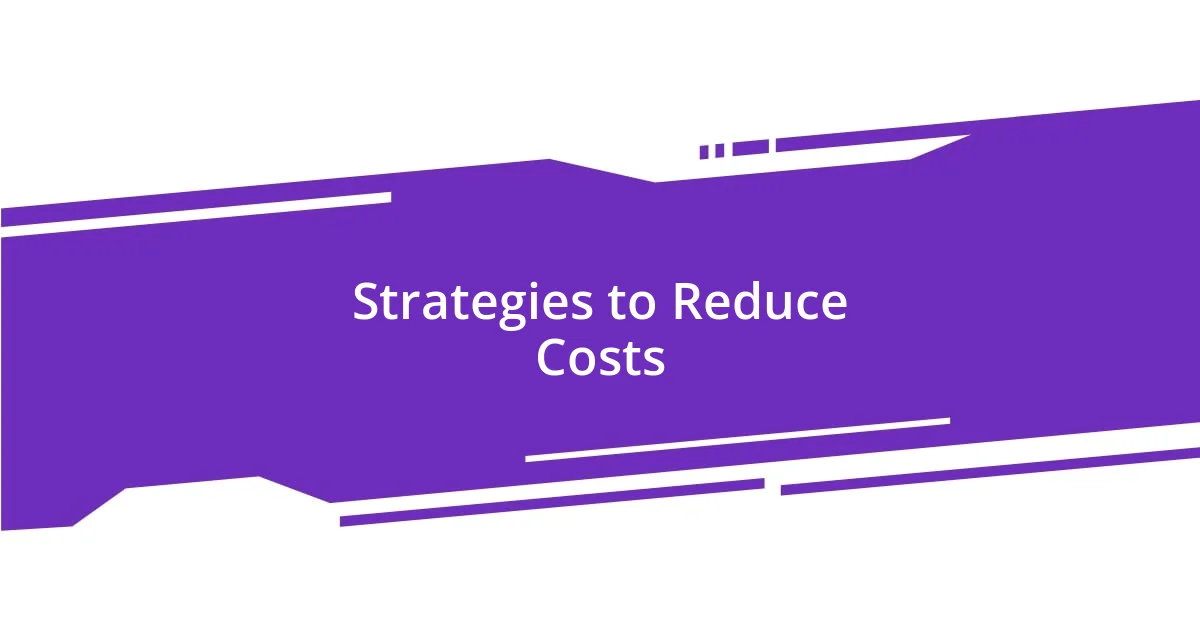Key takeaways:
- Off-peak rates offer significant financial savings and enhanced experiences through reduced demand, enabling quieter and more enjoyable activities.
- Identifying off-peak times requires examining local schedules, using apps, and observing community patterns to optimize savings.
- Utilizing tools like smartphone apps, online portals, and smart home devices can help monitor usage, leading to proactive decision-making and further cost reductions.

Understanding Off-Peak Rates
Off-peak rates refer to the lower prices offered during times of reduced demand for services, be it electricity, travel, or even lodging. I remember the first time I booked a flight for early morning on a Tuesday. I was pleasantly surprised by how much I saved compared to weekend rates; it felt like discovering a hidden treasure just by adjusting my schedule a bit.
Have you ever considered how much money you could save by simply shifting your habits? I’ve found that planning errands or leisure activities during off-peak hours not only helps my wallet but also allows me to enjoy a much quieter experience. Picture a serene grocery store aisle or a nearly empty highway—it’s a world apart from the usual chaos!
Moreover, understanding off-peak rates can completely reshape how we approach our daily routines. I often reflect on how flexible scheduling can lead to profound benefits, both financially and emotionally. Embracing these times has turned mundane tasks into moments of peaceful solitude, transforming my everyday experiences into something more enjoyable.

Identifying Off-Peak Timeframes
When it comes to identifying off-peak timeframes, I always start by examining my local services’ schedules. For instance, I realized that visiting the gym mid-morning works wonders. The crowd is minimal, and I can have clear access to my favorite equipment without waiting, making my workout more enjoyable and efficient.
Here are some practical tips to help you pinpoint off-peak times:
- Check provider schedules: Service companies often post peak and off-peak hours on their websites.
- Use apps or websites: Many travel and utility platforms have built-in tools to display off-peak pricing.
- Observe patterns: Keep an eye on your routine; patterns often emerge when you notice quieter times in your community.
- Experiment with timing: Try different times for errands or activities. I once found that late afternoons during the week are perfect for grocery shopping.
- Community feedback: Speak with friends or neighbors; they may share insights about their experiences during different times.
Identifying off-peak timeframes might seem straightforward, but it takes a bit of experimenting and observing your surroundings. I remember adjusting my commute to a less popular time and discovering not just less traffic, but also a more relaxed drive—an unexpected pleasure that turned the mundane into a small daily escape.

Benefits of Off-Peak Usage
When I think about the benefits of off-peak usage, the financial savings often come to mind first. I remember the excitement of receiving my utility bill, which was significantly lower after consistently running my dishwasher at night. This small switch not only saved me money but also made me feel like I was being smarter and more resourceful with my budget.
Beyond the cost savings, there’s a surprising sense of peace during off-peak hours. My recent visit to a popular restaurant on a Tuesday evening was a revelation. The ambiance was intimate, the service attentive, and I truly felt like I was enjoying a hidden gem in my city, away from the bustling weekend crowds. It’s remarkable how changing my timing can turn a simple meal into a memorable experience.
Lastly, off-peak usage can contribute to a more sustainable lifestyle. By consuming services when demand is lower, I’m playing a small role in reducing strain on resources. For instance, I’ve started planning my errands based on off-peak times, which not only eases congestion but also makes my trips feel less rushed and more enjoyable. I often think: wouldn’t we all benefit from a little less chaos in our daily lives?
| Factor | Benefit |
|---|---|
| Cost Savings | Lower prices lead to significant monthly savings. |
| Less Crowding | Enjoy quieter experiences with more attention from service providers. |
| Sustainability | Reduced demand helps lower the environmental impact. |

Strategies to Reduce Costs
Adjusting my habits to leverage off-peak rates has dramatically cut my monthly expenses. For example, I switched my laundry day to Wednesday afternoons, and the difference was immediate. Not only did I save on energy costs, but it was also refreshing to have the laundry room all to myself, allowing me to multi-task while avoiding any disruptions.
Another strategy I’ve adopted is timing my takeout orders. I started ordering dinner a bit earlier on weekdays, specifically on Mondays to take advantage of those special deals many restaurants offer to boost their weekday sales. I remember the first time I scored a fantastic deal: a delicious family meal that would usually cost a pretty penny ended up being half-priced. With each order, I felt a little win, delighting in both the meal and the savings.
To maximize the benefits of off-peak pricing, I’ve learned to bundle tasks strategically. For example, I now schedule grocery shopping during late morning hours after my gym session, and it’s been a game-changer. This combined trip not only frees up my afternoon, but I often find myself pleasantly surprised at the discounts available during those times. As I stroll through the aisles enjoying the quieter atmosphere, I sometimes wonder: could this simple shift in timing be the secret to a more organized and enjoyable week? Absolutely.

Tools to Monitor Usage
To effectively monitor usage and optimize off-peak savings, I’ve leaned on a couple of handy tools. One of my favorites is a simple smartphone app that tracks energy consumption in real time. I remember the first time I saw my usage drop during off-peak hours; it was a gratifying light-bulb moment. Seeing those numbers shift as I adjusted my habits reminded me how impactful small changes can be.
Another valuable resource in my arsenal is my utility company’s online portal. This platform provides personalized insights based on my usage patterns. The alerts I receive about peak times and potential savings always keep me on my toes. I recall one late evening when I received a notification about impending higher rates. It prompted me to delay running my dishwasher, and that small decision saved me a few bucks—thinking back, it feels rewarding to be proactive rather than reactive.
For a more focused approach, I’ve also utilized smart home devices. I acquired a smart thermostat that not only adjusts based on my schedule but also offers reports on my energy use. It’s like having a personal assistant reminding me to cut back during those high-demand hours. I can’t help but think: why wouldn’t anyone want this level of control? It feels empowering to have such tools at my fingertips, enabling me to tailor my energy habits to be both eco-friendly and budget-conscious.

Real-Life Success Stories
One of my friends shared a fantastic success story about cutting costs on her monthly internet bill. She realized that by changing her streaming habits to late-night hours, she could take advantage of the lower rates her provider offered. When she first noticed the extra savings on her bill, you could almost hear her excitement through the phone! It was a small calendar change, but it transformed her financial month.
Then there’s my coworker, who made a conscious effort to plan her road trips during off-peak seasons. She often talks about how freeing it was to explore national parks with fewer crowds and lower gas prices. The joy on her face was palpable when she recounted her last trip, where she also stumbled upon a charming local diner that only opened during off-peak months. I still remember her asking, “How could I have missed this delightful experience all this time?” It’s as if she not only saved money but also discovered a new world of opportunities.
Lastly, I recall a family down the street who scheduled their home maintenance tasks for off-peak times set by local services. They managed to get deals on everything from landscaping to plumbing repairs, which shifted their budget significantly. I remember chatting with them about a major plumbing issue they fixed for a fraction of the usual cost. They honestly couldn’t believe their luck and often encouraged their friends to think about timing when making repairs. It made me wonder, how many savings have we all overlooked simply because of timing?

Tips for Maximizing Savings
When it comes to maximizing savings, planning is key. Personally, I’ve found that mapping out my energy-intensive activities to correspond with off-peak rates has made a significant difference. For instance, I shifted my laundry day to the evening. Not only did I notice a decrease in my utility bill, but it also freed up my daytime hours for other activities—talk about a win-win!
Another strategy I’ve seen work wonders is being intentional about peak times. I remember a weekend when I intentionally chose to run my air conditioning less during the hotter hours. There was that initial discomfort, but afterward, I was pleasantly surprised to see how much of a dent it put in my overall bill. It’s all about making those small sacrifices; after all, isn’t it more satisfying to feel the rewards of conscious effort?
Finally, consider bundling your savings strategies. I combined my off-peak energy usage with other cost-saving habits like meal prepping and grocery shopping during sales. The sense of accomplishment I felt each time I opened my pantry and saw only great deals was incredible. Have you ever realized that changing just a few habits can lead to a significant financial change? It’s empowering to see how interconnected our choices are—making those adjustments allows us not only to save money but also to celebrate the lifestyle we cultivate.














